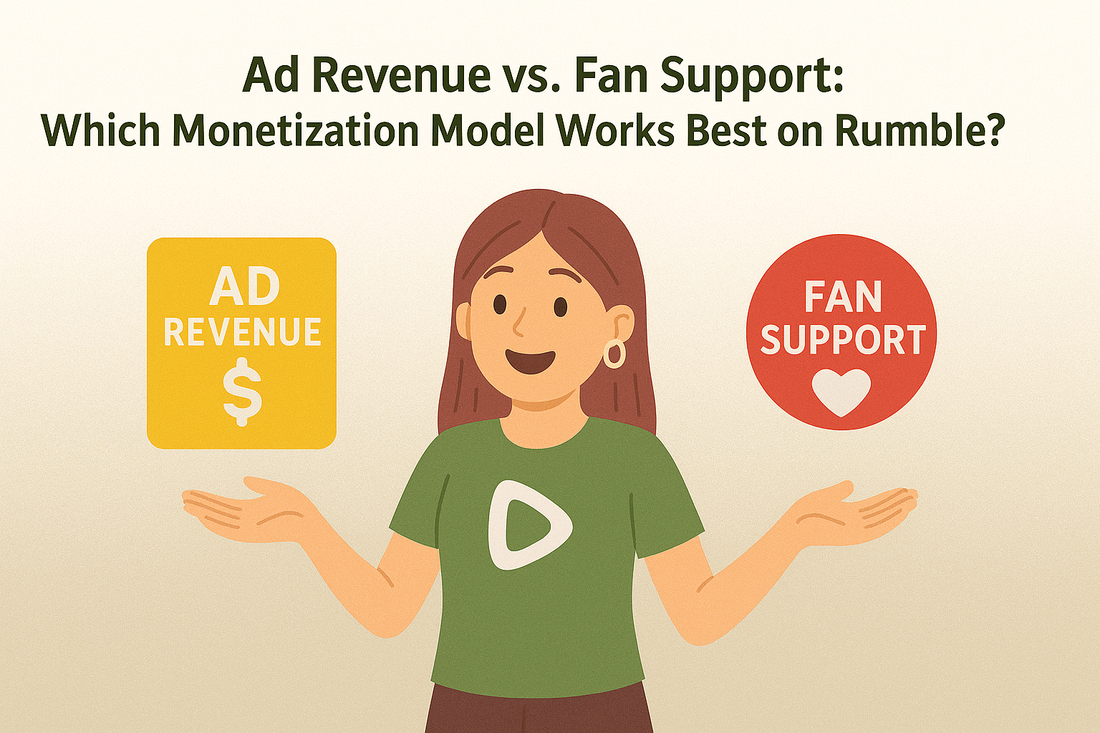
Ad Revenue vs. Fan Support: Which Monetization Model Works Best on Rumble?
Monetizing content on Rumble offers creators more freedom than traditional platforms — but it also raises a key question: What works better — ad revenue or fan support?
Whether you're a political commentator, wellness educator, or gaming streamer, knowing which revenue model pays off can shape your entire content strategy.
In this article, we break down:
- How Rumble’s ad and fan support systems actually work
- Real-world earnings examples from top creators
- Data on engagement and conversion
- Pros, cons, and practical tips for both monetization models
How Monetization on Rumble Works
Rumble offers two primary paths to monetization:
1. Ad Revenue (Rumble Ads & Video Licensing)
- Revenue from in-video ads, pre-rolls, and sponsorships
- Option for Rumble Exclusivity which boosts discoverability
- Earnings based on views, category, geography, engagement
Reference: Rumble Creator Monetization FAQ
2. Fan Support (Tips, Subscriptions, Mug Club, Locals)
- Includes Rants (tips), livestream donations, and Locals.com memberships
- Popular among creators with loyal niche audiences
1. Ad Revenue: How Much Do Creators Really Earn?
Data Snapshot:
- Average CPM on Rumble: $4–$15
- 100K views = $500–$1,500
- 1M views = $3,000–$10,000

Case Study: Dan Bongino reportedly earns seven figures via Rumble ads and licensing. His videos average over 300K views and are highly advertiser-relevant.
Pros:
- Scales well with reach
- Generates passive income from older videos
- Rumble's homepage can give extra visibility
Cons:
- Heavily reliant on views and platform promotion
- CPM can drop for controversial content
- Performance fluctuates with news cycles

2. Fan Support: Are Rants, Tips & Memberships More Reliable?
Data Snapshot:
- Average tip per viewer: $1–$5
- Monthly income from Locals: $2,000–$15,000+
- Conversion rate (followers → paying fans): 1–5%

Case Study: Steven Crowder generates millions annually via fan-supported models like Mug Club and Locals. His fans pay for exclusive content, community access, and livestream perks.
Pros:
- Revenue doesn’t depend on ads or algorithms
- Creates stable income with loyal audience
- Fosters deep engagement
Cons:
- Requires ongoing relationship-building
- Harder to scale quickly
- Success depends on personality and audience connection

Comparative Table: Rumble Ad Revenue vs Fan Support
| Model | Best For | Revenue Potential | Risks/Downsides |
|---|---|---|---|
| Ad Revenue | High-traffic creators | High with volume (CPM $4–$15) | Algorithm/reach dependent |
| Fan Support | Niche/loyal community creators | High with engagement (subs/tips) | Harder to scale, needs consistent effort |
What Type of Creators Should Use Which Model?
Use Ad Revenue if:
- You consistently hit 50K+ views per video
- Your content is advertiser-friendly (e.g. interviews, news)
- You benefit from homepage exposure or exclusivity deals
Use Fan Support if:
- You have a small but loyal audience
- You cover niche, controversial, or community-focused topics
- You want recurring monthly income
Use Both if:
- You livestream or post premium content
- You want layered monetization from both casual viewers and superfans
- You’re building a business or brand, not just chasing views
Conclusion: The Winning Model Depends on You
There’s no one-size-fits-all monetization strategy on Rumble. If you’re pulling massive view counts, ad revenue may be your strongest bet.
But for creators who prioritize community and connection — or who cover edgy or underrepresented topics — fan support is often more stable.
The smartest Rumble creators combine both models to diversify income and build sustainable growth.
🚀 Want to Grow Faster on Rumble?
Promo-SMM.com delivers real engagement—views, likes, comments, and followers—that work in harmony with Rumble’s algorithm. Boost your presence and let your videos stand out.
